Standard Explanation of the Instruction for Use of Consumer Products—Labelling for Detergents
National Technical Committee for Standardization of Surfactants and Detergents
Introduction:The national standard of the Instruction for Use of Consumer Products—Labelling for Detergents, GB/T 36970-2018, published by State Administration for Market Regulation and China National Standardization Management Committee was put into force on July 1, 2019.The secretariat of China Surfactant and Detergent Standardization Technology Committee explained some standard articles and aimed to help business have a correct understanding of the Instruction for Use of Consumer Products—Labelling for Detergents.It also aims to let consumers be aware of the washing products labels and consumption.
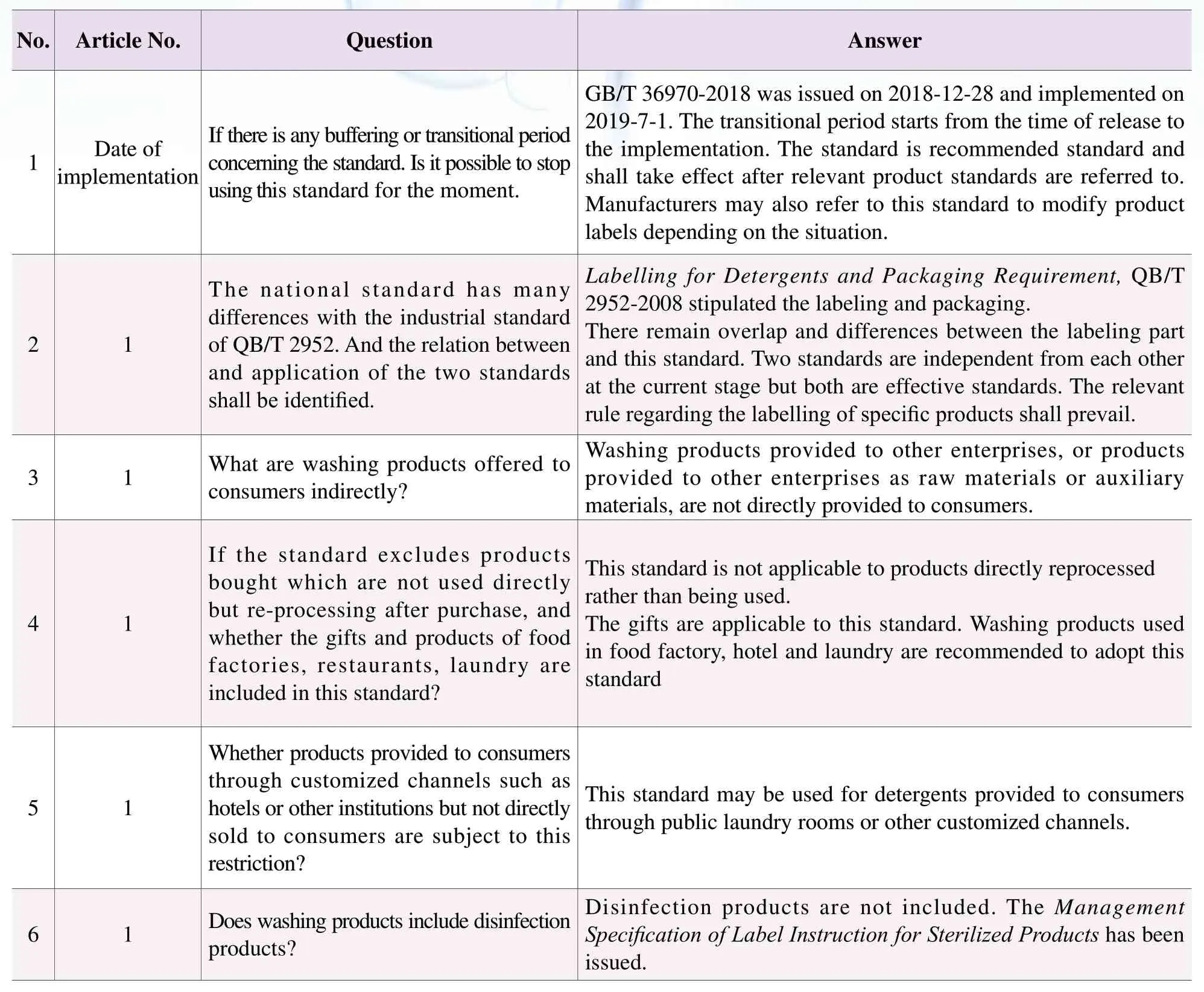
No.Article No.Question Answer 1 Date of implementation If there is any buffering or transitional period concerning the standard.Is it possible to stop using this standard for the moment.GB/T 36970-2018 was issued on 2018-12-28 and implemented on 2019-7-1.The transitional period starts from the time of release to the implementation.The standard is recommended standard and shall take effect after relevant product standards are referred to.Manufacturers may also refer to this standard to modify product labels depending on the situation.Labelling for Detergents and Packaging Requirement, QB/T 2952-2008 stipulated the labeling and packaging.There remain overlap and differences between the labeling part and this standard.Two standards are independent from each other at the current stage but both are effective standards.The relevant rule regarding the labelling of specific products shall prevail.3 1 What are washing products offered to consumers indirectly?2 1 The national standard has many differences with the industrial standard of QB/T 2952.And the relation between and application of the two standards shall be identified.Washing products provided to other enterprises, or products provided to other enterprises as raw materials or auxiliary materials, are not directly provided to consumers.4 1 If the standard excludes products bought which are not used directly but re-processing after purchase, and whether the gifts and products of food factories, restaurants, laundry are included in this standard?This standard is not applicable to products directly reprocessed rather than being used.The gifts are applicable to this standard.Washing products used in food factory, hotel and laundry are recommended to adopt this standard 5 1 Whether products provided to consumers through customized channels such as hotels or other institutions but not directly sold to consumers are subject to this restriction?This standard may be used for detergents provided to consumers through public laundry rooms or other customized channels.6 1 Does washing products include disinfection products?Disinfection products are not included.The Management Specification of Label Instruction for Sterilized Products has been issued.
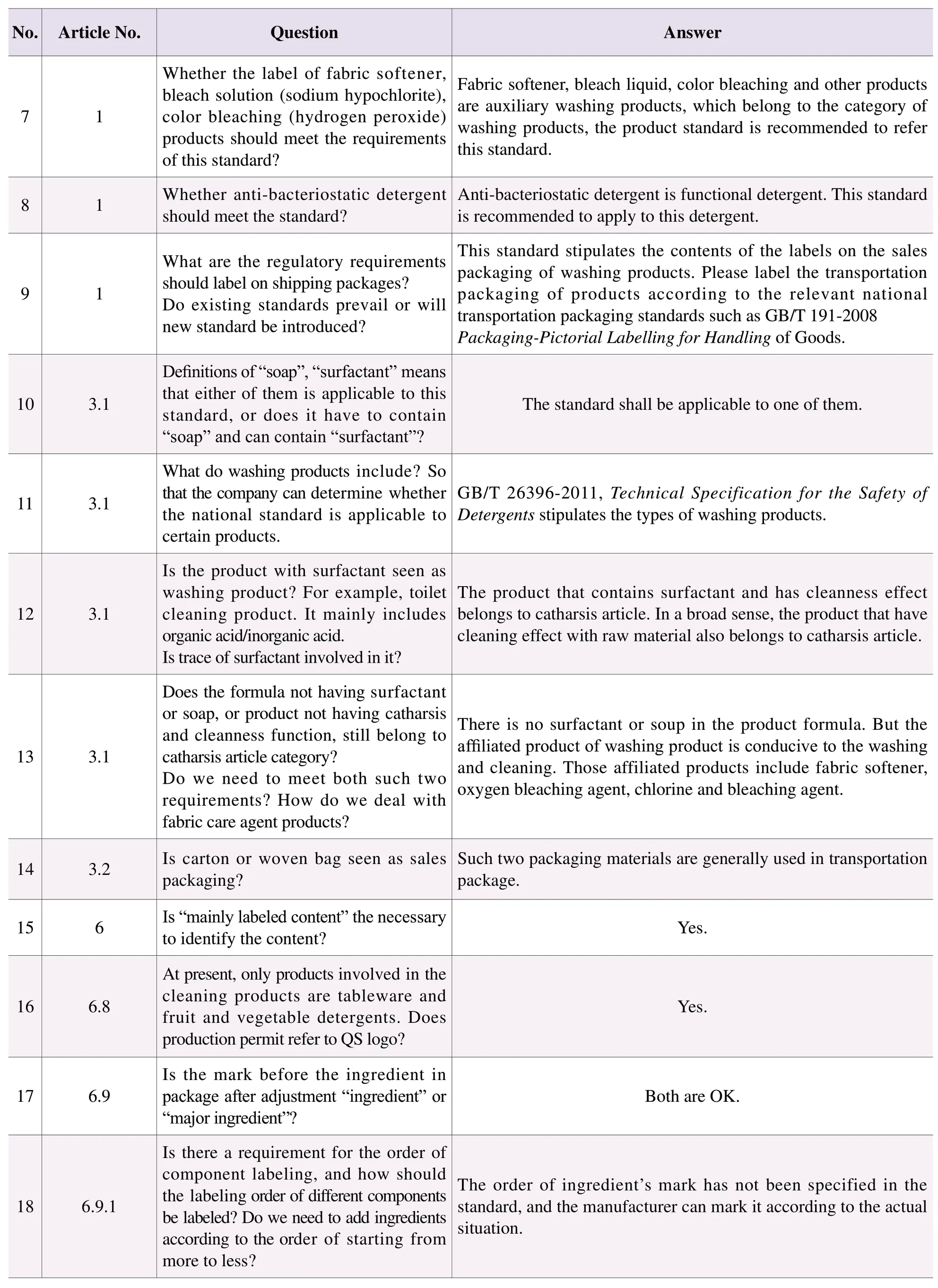
No.Article No.Question Answer 7 1 Whether the label of fabric softener, bleach solution (sodium hypochlorite), color bleaching (hydrogen peroxide) products should meet the requirements of this standard?Fabric softener, bleach liquid, color bleaching and other products are auxiliary washing products, which belong to the category of washing products, the product standard is recommended to refer this standard.8 1 Whether anti-bacteriostatic detergent should meet the standard?Anti-bacteriostatic detergent is functional detergent.This standard is recommended to apply to this detergent.9 1 What are the regulatory requirements should label on shipping packages?Do existing standards prevail or will new standard be introduced?This standard stipulates the contents of the labels on the sales packaging of washing products.Please label the transportation packaging of products according to the relevant national transportation packaging standards such as GB/T 191-2008 Packaging-Pictorial Labelling for Handling of Goods.10 3.1 Definitions of “soap”, “surfactant” means that either of them is applicable to this standard, or does it have to contain “soap” and can contain “surfactant”?The standard shall be applicable to one of them.11 3.1 What do washing products include? So that the company can determine whether the national standard is applicable to certain products.GB/T 26396-2011, Technical Specification for the Safety of Detergents stipulates the types of washing products.12 3.1 Is the product with surfactant seen as washing product? For example, toilet cleaning product.It mainly includes organic acid/inorganic acid.Is trace of surfactant involved in it?The product that contains surfactant and has cleanness effect belongs to catharsis article.In a broad sense, the product that have cleaning effect with raw material also belongs to catharsis article.13 3.1 Does the formula not having surfactant or soap, or product not having catharsis and cleanness function, still belong to catharsis article category?Do we need to meet both such two requirements? How do we deal with fabric care agent products? There is no surfactant or soup in the product formula.But the affiliated product of washing product is conducive to the washing and cleaning.Those affiliated products include fabric softener, oxygen bleaching agent, chlorine and bleaching agent.14 3.2 Is carton or woven bag seen as sales packaging?Such two packaging materials are generally used in transportation package.15 6 Is “mainly labeled content” the necessary to identify the content? Yes.16 6.8 At present, only products involved in the cleaning products are tableware and fruit and vegetable detergents.Does production permit refer to QS logo?Yes.17 6.9 Is the mark before the ingredient in package after adjustment “ingredient” or “major ingredient”?Both are OK.18 6.9.1 Is there a requirement for the order of component labeling, and how should the labeling order of different components be labeled? Do we need to add ingredients according to the order of starting from more to less?The order of ingredient’s mark has not been specified in the standard, and the manufacturer can mark it according to the actual situation.
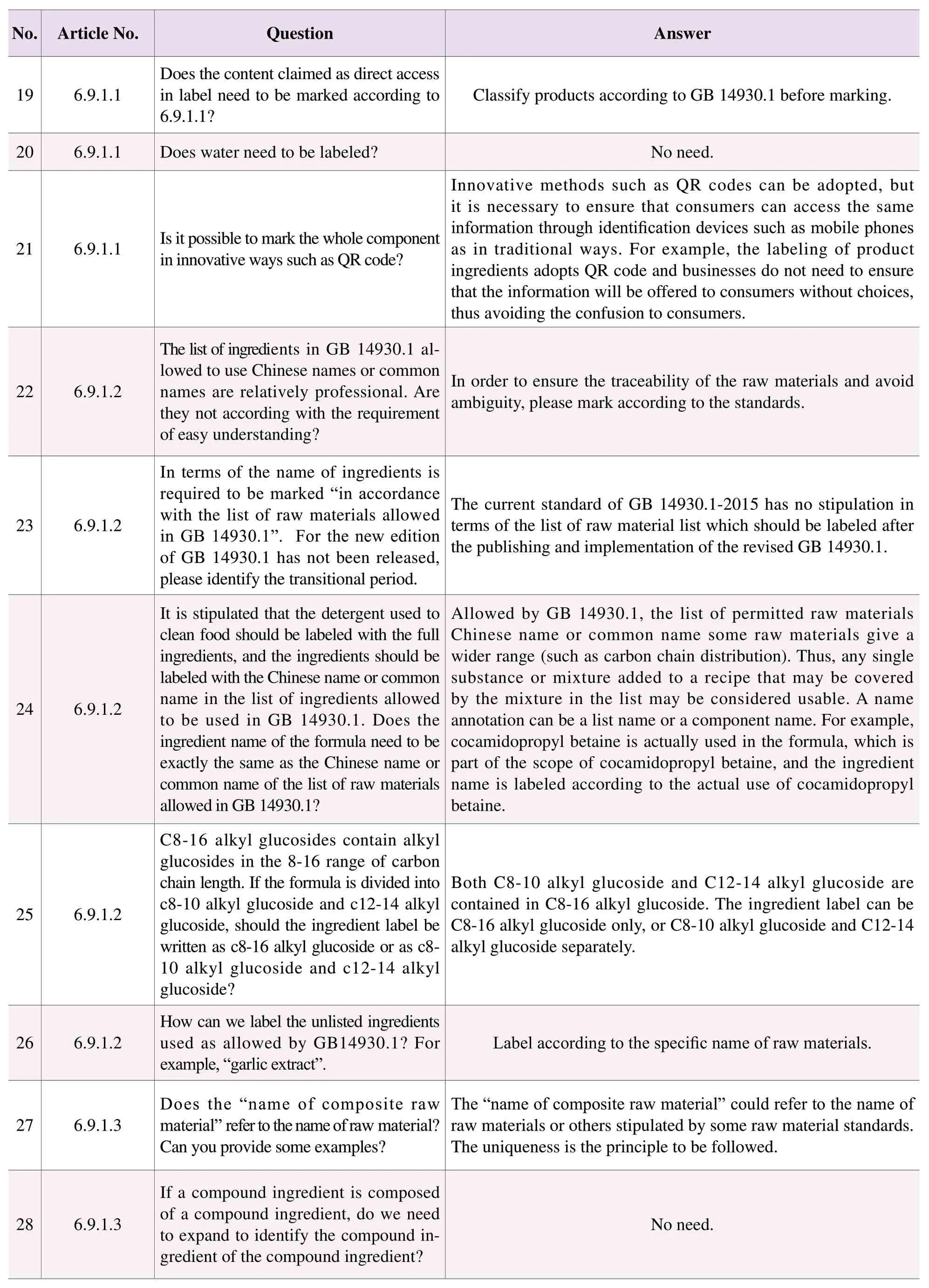
No.Article No.Question Answer 19 6.9.1.1 Does the content claimed as direct access in label need to be marked according to 6.9.1.1?Classify products according to GB 14930.1 before marking.20 6.9.1.1 Does water need to be labeled? No need.21 6.9.1.1 Is it possible to mark the whole component in innovative ways such as QR code? Innovative methods such as QR codes can be adopted, but it is necessary to ensure that consumers can access the same information through identification devices such as mobile phones as in traditional ways.For example, the labeling of product ingredients adopts QR code and businesses do not need to ensure that the information will be offered to consumers without choices, thus avoiding the confusion to consumers.22 6.9.1.2 The list of ingredients in GB 14930.1 allowed to use Chinese names or common names are relatively professional.Are they not according with the requirement of easy understanding?In order to ensure the traceability of the raw materials and avoid ambiguity, please mark according to the standards.23 6.9.1.2 In terms of the name of ingredients is required to be marked “in accordance with the list of raw materials allowed in GB 14930.1”.For the new edition of GB 14930.1 has not been released, please identify the transitional period.The current standard of GB 14930.1-2015 has no stipulation in terms of the list of raw material list which should be labeled after the publishing and implementation of the revised GB 14930.1.24 6.9.1.2 It is stipulated that the detergent used to clean food should be labeled with the full ingredients, and the ingredients should be labeled with the Chinese name or common name in the list of ingredients allowed to be used in GB 14930.1.Does the ingredient name of the formula need to be exactly the same as the Chinese name or common name of the list of raw materials allowed in GB 14930.1?Allowed by GB 14930.1, the list of permitted raw materials Chinese name or common name some raw materials give a wider range (such as carbon chain distribution).Thus, any single substance or mixture added to a recipe that may be covered by the mixture in the list may be considered usable.A name annotation can be a list name or a component name.For example, cocamidopropyl betaine is actually used in the formula, which is part of the scope of cocamidopropyl betaine, and the ingredient name is labeled according to the actual use of cocamidopropyl betaine.25 6.9.1.2 C8-16 alkyl glucosides contain alkyl glucosides in the 8-16 range of carbon chain length.If the formula is divided into c8-10 alkyl glucoside and c12-14 alkyl glucoside, should the ingredient label be written as c8-16 alkyl glucoside or as c8-10 alkyl glucoside and c12-14 alkyl glucoside?Both C8-10 alkyl glucoside and C12-14 alkyl glucoside are contained in C8-16 alkyl glucoside.The ingredient label can be C8-16 alkyl glucoside only, or C8-10 alkyl glucoside and C12-14 alkyl glucoside separately.26 6.9.1.2 How can we label the unlisted ingredients used as allowed by GB14930.1? For example, “garlic extract”.Label according to the specific name of raw materials.27 6.9.1.3 Does the “name of composite raw material” refer to the name of raw material? Can you provide some examples?The “name of composite raw material” could refer to the name of raw materials or others stipulated by some raw material standards.The uniqueness is the principle to be followed.28 6.9.1.3 If a compound ingredient is composed of a compound ingredient, do we need to expand to identify the compound ingredient of the compound ingredient?No need.
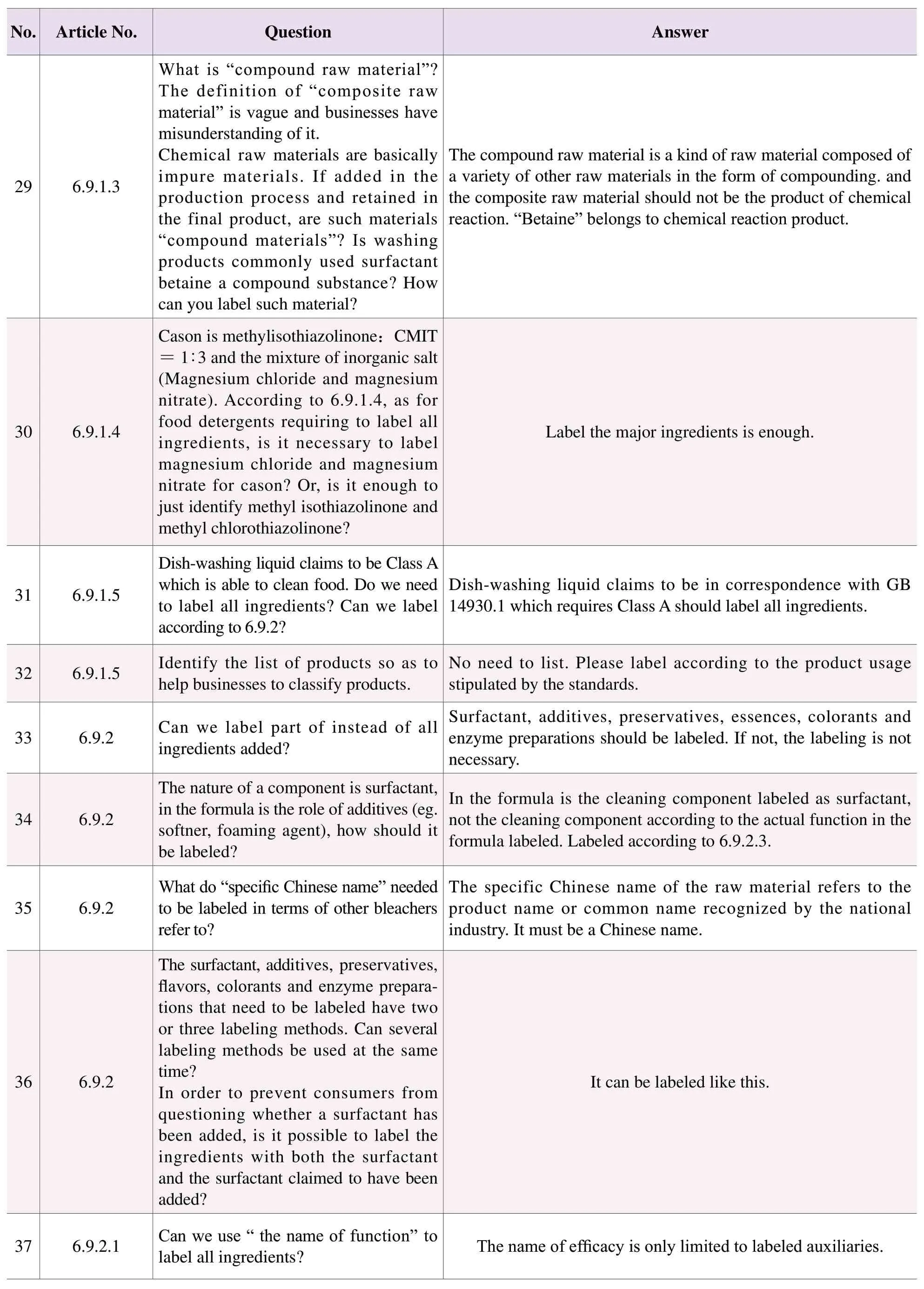
No.Article No.Question Answer 29 6.9.1.3 What is “compound raw material”? The definition of “composite raw material” is vague and businesses have misunderstanding of it.Chemical raw materials are basically impure materials.If added in the production process and retained in the final product, are such materials “compound materials”? Is washing products commonly used surfactant betaine a compound substance? How can you label such material?The compound raw material is a kind of raw material composed of a variety of other raw materials in the form of compounding.and the composite raw material should not be the product of chemical reaction.“Betaine” belongs to chemical reaction product.30 6.9.1.4 Cason is methylisothiazolinone:CMIT=1:3 and the mixture of inorganic salt (Magnesium chloride and magnesium nitrate).According to 6.9.1.4, as for food detergents requiring to label all ingredients, is it necessary to label magnesium chloride and magnesium nitrate for cason? Or, is it enough to just identify methyl isothiazolinone and methyl chlorothiazolinone?Label the major ingredients is enough.31 6.9.1.5 Dish-washing liquid claims to be Class A which is able to clean food.Do we need to label all ingredients? Can we label according to 6.9.2?Dish-washing liquid claims to be in correspondence with GB 14930.1 which requires Class A should label all ingredients.No need to list.Please label according to the product usage stipulated by the standards.33 6.9.2 Can we label part of instead of all ingredients added?32 6.9.1.5 Identify the list of products so as to help businesses to classify products.Surfactant, additives, preservatives, essences, colorants and enzyme preparations should be labeled.If not, the labeling is not necessary.34 6.9.2 The nature of a component is surfactant, in the formula is the role of additives (eg.softner, foaming agent), how should it be labeled?In the formula is the cleaning component labeled as surfactant, not the cleaning component according to the actual function in the formula labeled.Labeled according to 6.9.2.3.35 6.9.2 What do “specific Chinese name” needed to be labeled in terms of other bleachers refer to?The specific Chinese name of the raw material refers to the product name or common name recognized by the national industry.It must be a Chinese name.36 6.9.2 The surfactant, additives, preservatives, flavors, colorants and enzyme preparations that need to be labeled have two or three labeling methods.Can several labeling methods be used at the same time?In order to prevent consumers from questioning whether a surfactant has been added, is it possible to label the ingredients with both the surfactant and the surfactant claimed to have been added?It can be labeled like this.37 6.9.2.1 Can we use “ the name of function” to label all ingredients? The name of efficacy is only limited to labeled auxiliaries.
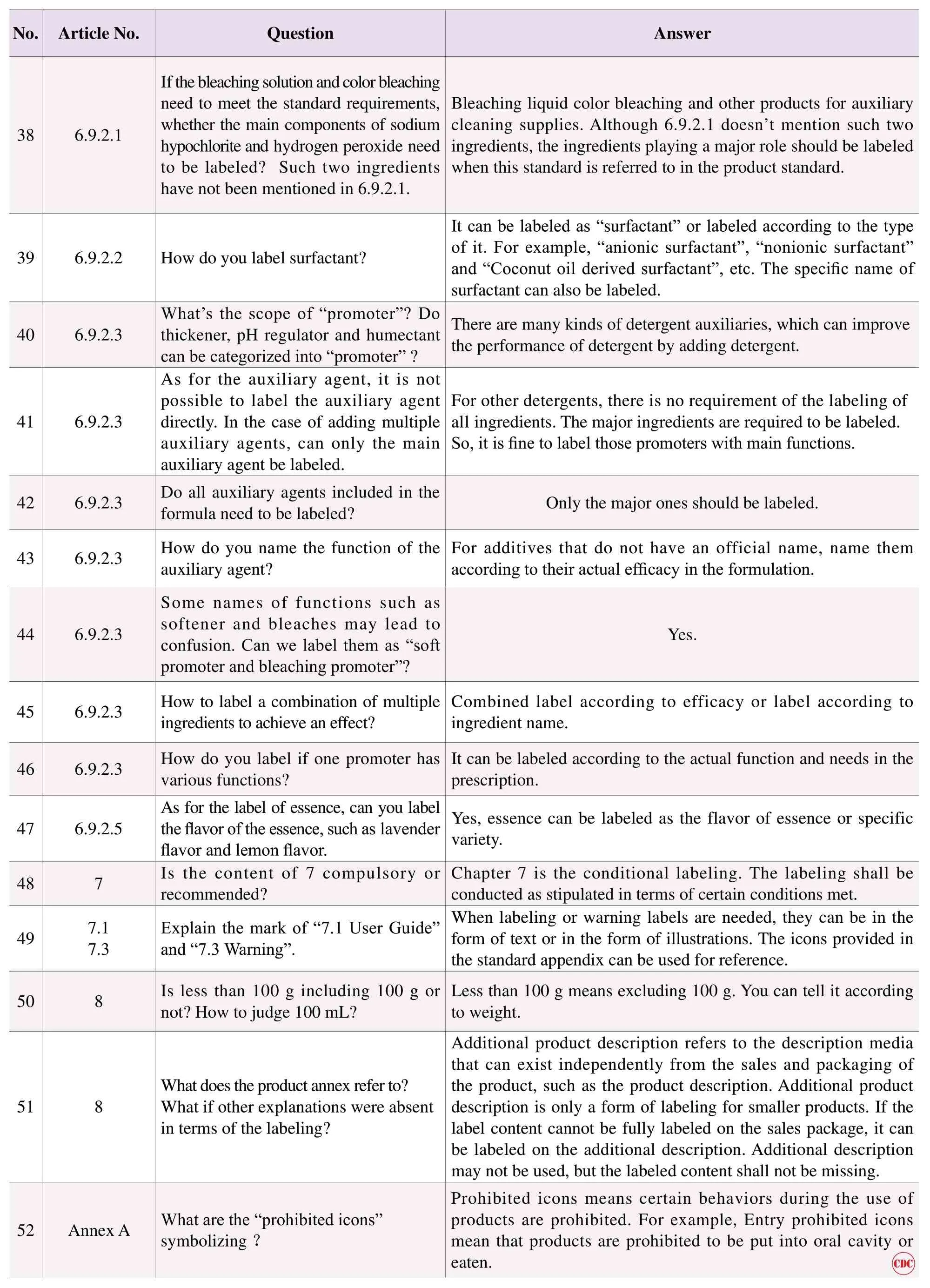
No.Article No.Question Answer 38 6.9.2.1 If the bleaching solution and color bleaching need to meet the standard requirements, whether the main components of sodium hypochlorite and hydrogen peroxide need to be labeled? Such two ingredients have not been mentioned in 6.9.2.1.Bleaching liquid color bleaching and other products for auxiliary cleaning supplies.Although 6.9.2.1 doesn’t mention such two ingredients, the ingredients playing a major role should be labeled when this standard is referred to in the product standard.39 6.9.2.2 How do you label surfactant?It can be labeled as “surfactant” or labeled according to the type of it.For example, “anionic surfactant”, “nonionic surfactant” and “Coconut oil derived surfactant”, etc.The specific name of surfactant can also be labeled.40 6.9.2.3 What's the scope of “promoter”? Do thickener, pH regulator and humectant can be categorized into “promoter” ?There are many kinds of detergent auxiliaries, which can improve the performance of detergent by adding detergent.41 6.9.2.3 As for the auxiliary agent, it is not possible to label the auxiliary agent directly.In the case of adding multiple auxiliary agents, can only the main auxiliary agent be labeled.For other detergents, there is no requirement of the labeling of all ingredients.The major ingredients are required to be labeled.So, it is fine to label those promoters with main functions.42 6.9.2.3 Do all auxiliary agents included in the formula need to be labeled? Only the major ones should be labeled.43 6.9.2.3 How do you name the function of the auxiliary agent?For additives that do not have an official name, name them according to their actual efficacy in the formulation.44 6.9.2.3 Some names of functions such as softener and bleaches may lead to confusion.Can we label them as “soft promoter and bleaching promoter”?Yes.Combined label according to efficacy or label according to ingredient name.46 6.9.2.3 How do you label if one promoter has various functions?45 6.9.2.3 How to label a combination of multiple ingredients to achieve an effect?It can be labeled according to the actual function and needs in the prescription.Yes, essence can be labeled as the flavor of essence or specific variety.48 7 Is the content of 7 compulsory or recommended?47 6.9.2.5 As for the label of essence, can you label the flavor of the essence, such as lavender flavor and lemon flavor.Chapter 7 is the conditional labeling.The labeling shall be conducted as stipulated in terms of certain conditions met.49 7.1 7.3 When labeling or warning labels are needed, they can be in the form of text or in the form of illustrations.The icons provided in the standard appendix can be used for reference.50 8 Is less than 100 g including 100 g or not? How to judge 100 mL?Explain the mark of “7.1 User Guide” and “7.3 Warning”.Less than 100 g means excluding 100 g.You can tell it according to weight.51 8 What does the product annex refer to?What if other explanations were absent in terms of the labeling?Additional product description refers to the description media that can exist independently from the sales and packaging of the product, such as the product description.Additional product description is only a form of labeling for smaller products.If the label content cannot be fully labeled on the sales package, it can be labeled on the additional description.Additional description may not be used, but the labeled content shall not be missing.52 Annex A What are the “prohibited icons” symbolizing?Prohibited icons means certain behaviors during the use of products are prohibited.For example, Entry prohibited icons mean that products are prohibited to be put into oral cavity or eaten.CDC
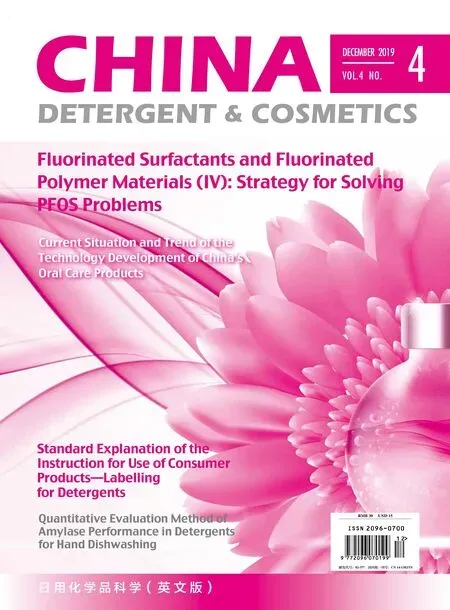 China Detergent & Cosmetics2019年4期
China Detergent & Cosmetics2019年4期
- China Detergent & Cosmetics的其它文章
- Fluorinated Surfactants and Fluorinated Polymer Materials (IV):Strategy for Solving PFOS Problems
- Quantitative Evaluation Method of Amylase Performance in Detergents for Hand Dishwashing
- Research and Safety Evaluation of Thallium in Cosmetic Products
- A Study on the Whitening Efficacy of Flavones in Lotus Leaf
- Refutation of Cosmetics Rumors
- Flight Inspection Analysis on National Cosmetics in 2018
